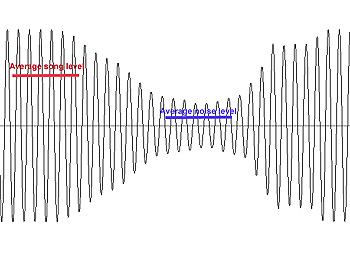Q: Can you explain in detail how Popper minimizes the hiss from a tape?
A: To lower the tape hiss, DePopper converts your song to 1024 frequency bands first. Each frequency band, isolated, looks like a modulated sine wave if converted back to time domain. Then, for each frequency band, DePopper finds the time window (46 ms second long) where the average level is minimum, but not zero. DePopper will use assume the average level of this time window as the average noise level. For the same frequency band, DePopper will also compute the overall average level, which is assumed to be the average song level. DePopper does this for each one of the 1024 frequency bands:
After this analysis, in order to increase the signal to noise ratio DePopper does a second sweep. In this second sweep, DePopper leaves the passages above the red level untouched. However, for passages below the red level, DePopper decrease their levels even more, proportionally to their closeness to the blue level (including the blue level itself, where the decrease is maximum). By doing this for all frequency bands, after reassembling the original song you will get less noise without distorting the song (unlike the distortion that would appear if DePopper did the same thing to the original song without splitting it into separate bands).
The Trigger value that you see in Minimize Hiss settings raises the red bar above the average level, or lowers it, depending on its positive or negative value. The Factor value increases the attenuation of the levels close to the blue bar.
As you can see, this process is self-adaptive, perfect for batch processing many different files. It is effective against any kind of non-variable noise, including some types of rumble.
However, there is a weak point: if you have a passage with very low hiss that does not belong to the original tape, for example only the hiss from the preamp, DePopper will use this hiss level as its reference of average hiss and probably won't remove any real noise. This is because because the real noise will be far above the preamp hiss. And if you do not have any passage that has real noise only, you may get funny sci-fi sounds.
So, in order to this automatic noise removal work properly, the source sample should not contain any noise that does not belong to the original recording. For this reason we recommend to start playing the source tape (on the cassette deck) some seconds before the song begins and then, only with the original source already playing, click the Rec button on the recording software. After the end of the song, do the inverse: click the Stop button on the software and only after this press Stop on the cassette deck (before the tape reaches its non-magnetic area). Same for vinyl records. Normally people have to record their tapes anyway, so this is does not add extra work. The user will record a dozen audio files, put them all in DePopper and leave DePopper automatically detecting and removing the tape hiss while he/she will do something else (or perhaps the vinyl sound if its noise is uniform and low).
But what if the samples were already recorded and they have low hiss passages that are not part of the original source? Simply load them in a wave editor and cut away all the passages that are not "real hiss" (usually they will be in the beginning or at the end).
This picture shows the beginning of a song that has a initial preamp hiss and what to do:
Finally, the Restrict Prediction setting. It is intended for people that can't use the automatic hiss detection, frequently because the songs were already recorded without any "noise only" passage. If there is no such "noise only" passage, strange things can happen. For example, an instrument that plays uniformly during the entire source length can be attenuated. When you enable the Restrict Prediction setting, you are telling DePopper: "Don't try to autodetect the tape hiss, use a predefined white noise as if it was the detected hiss reference". This is less efficient than the automatic detection, but does not require any kind of special care when recording, so many people prefer this way.
You may be asking why we don't add a graphic screen where you could mark the noise reference passage, in addition to the automatic mode. There are two reasons: the first of them is that the graphic screen would add a per-file adjust, while DePopper is made for batch processing, with all files using the same settings in a single session. The second reason is the number of blind users that DePopper has: they cannot use graphic interfaces.



